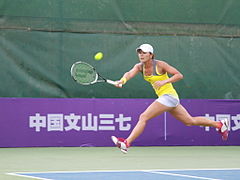Miki Miyamura
 Miki Miyamura w 2013 roku | ||||||||||
| Państwo | ||||||||||
|---|---|---|---|---|---|---|---|---|---|---|
| Data i miejsce urodzenia | 4 listopada 1985 Kodaira, Tokio | |||||||||
| Gra | praworęczna | |||||||||
| Zakończenie kariery | aktywna | |||||||||
| Trener | Toshihisa Tsuchihashi, Hiroshi Miyamura | |||||||||
| Gra pojedyncza | ||||||||||
| Wygrane turnieje | 0 WTA, 4 ITF | |||||||||
| Najwyżej w rankingu | 310 (21 kwietnia 2014) | |||||||||
| Gra podwójna | ||||||||||
| Wygrane turnieje | 0 WTA, 20 ITF | |||||||||
| Najwyżej w rankingu | 110 (21 października 2013) | |||||||||
| Australian Open | 1R (2014) | |||||||||
| Dorobek medalowy | ||||||||||
| ||||||||||
Miki Miyamura (jap. 宮村美紀 Miyamura Miki; ur. 4 listopada 1985) – japońska tenisistka, medalistka Letniej Uniwersjady 2009.
W 2009 roku podczas Letniej Uniwersjady 2009 w Belgradzie razem z Shūko Aoyamą zdobyły brązowy medal w konkurencji gry podwójnej.
W 2003 roku po raz pierwszy zagrała w turnieju głównym rozgrywek singlowych cyklu ITF – w Sutamie przegrała w pierwszej rundzie z Dianą Julianto 0:6, 5:7.
W przeciągu kariery wygrała trzy turnieje w grze pojedynczej i dziewiętnaście w grze podwójnej rangi ITF.
W sezonie 2014 zadebiutowała w rozgrywkach wielkoszlemowych – rywalizowała w zawodach gry podwójnej na kortach Australian Open, jednak przegrała w swoim pierwszym meczu.
Wygrane turnieje rangi ITF
| turnieje z pulą nagród 100 000 $ |
| turnieje z pulą nagród 75 000 $ |
| turnieje z pulą nagród 50 000 $ |
| turnieje z pulą nagród 25 000 $ |
| turnieje z pulą nagród 15 000 $ |
| turnieje z pulą nagród 10 000 $ |
Gra pojedyncza
| Data | Turniej | Pula | Naw. | Finalistka | Wynik | |
| 1. | 22/06/2008 | 10 000 | ceglana | 6:3, 6:3 | ||
| 2. | 17/10/2009 | 10 000 | twarda | 6:3, 6:3 | ||
| 3. | 21/03/2015 | 10 000 | twarda | 6:4, 6:2 | ||
| 4. | 11/09/2016 | 10 000 | twarda | 6:1, 6:4 |
Gra podwójna
| Data | Turniej | Pula | Naw. | Partnerka | Finalistki | Wynik | |
| 1. | 03/09/2006 | 10 000 | twarda | 6:1, 1:6, 7:6(6) | |||
| 2. | 06/04/2008 | 10 000 | twarda | 6:0, 6:1 | |||
| 3. | 09/05/2008 | 10 000 | ceglana | 7:6(6), 6:2 | |||
| 4. | 15/06/2008 | 10 000 | twarda | 6:4, 6:2 | |||
| 5. | 18/09/2009 | 10 000 | twarda | 2:6, 6:2, 10–6 | |||
| 6. | 26/09/2009 | 10 000 | twarda | 6:1, 6:3 | |||
| 7. | 11/10/2009 | 10 000 | twarda | 6:1, 4:6, 10–5 | |||
| 8. | 17/10/2009 | 10 000 | twarda | 6:0, 6:3 | |||
| 9. | 25/04/2010 | 10 000 | dywanowa | 6:4, 7:6(7) | |||
| 10. | 02/05/2010 | 25 000 | ceglana | 6:4, 4:6, 10–5 | |||
| 11. | 26/06/2011 | 10 000 | twarda (hala) | 6:2, 7:5 | |||
| 12. | 28/10/2012 | 25 000 | trawiasta | 3:6, 6:4, 10–6 | |||
| 13. | 26/04/2013 | 50 000 | twarda | 7:5, 6:3 | |||
| 14. | 14/09/2013 | 25 000 | twarda | 6:4, 6:7(6), 11–9 | |||
| 15. | 23/02/2014 | 15 000 | twarda | 6:2, 6:2 |
Bibliografia
- Profil na stronie WTA (ang.). Women’s Tennis Association. [dostęp 11 lipca 2014].
- Profil na stronie ITF (ang.). International Tennis Federation. [dostęp 11 lipca 2014].
Media użyte na tej stronie
Pictograms of Olympic sports - Tennis. This is unofficial sample picture. Images of official Olympic pictograms for 1948 Summer Olympics and all Summer Olympics since 1964 can be found in corresponding Official Reports.
The Flag of India. The colours are saffron, white and green. The navy blue wheel in the center of the flag has a diameter approximately the width of the white band and is called Ashoka's Dharma Chakra, with 24 spokes (after Ashoka, the Great). Each spoke depicts one hour of the day, portraying the prevalence of righteousness all 24 hours of it.
The flag of Navassa Island is simply the United States flag. It does not have a "local" flag or "unofficial" flag; it is an uninhabited island. The version with a profile view was based on Flags of the World and as a fictional design has no status warranting a place on any Wiki. It was made up by a random person with no connection to the island, it has never flown on the island, and it has never received any sort of recognition or validation by any authority. The person quoted on that page has no authority to bestow a flag, "unofficial" or otherwise, on the island.
bendera Indonesia
The national flag of Kingdom of Thailand since September 2017; there are total of 3 colours:
- Red represents the blood spilt to protect Thailand’s independence and often more simply described as representing the nation.
- White represents the religion of Buddhism, the predominant religion of the nation
- Blue represents the monarchy of the nation, which is recognised as the centre of Thai hearts.
Autor: Timsong311, Licencja: CC BY-SA 3.0
Miki Miyamura at the 2013 ITF Women's Circuit – Wenshan tournament













